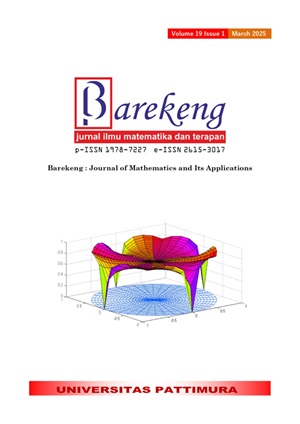COMPARISON OF SARIMA AND SARIMAX METHODS FOR FORECASTING HARVESTED DRY GRAIN PRICES IN INDONESIA
Abstract
Harvested dry grain (HDG) is a vital commodity for rice availability and plays a strategic role in Indonesia’s agricultural economy. Farmers typically sell HDG to rice millers post-harvest, yet disparities between farm-level selling prices and consumer-level purchase prices. This price gap can lead to financial losses for farmers, highlighting the need for accurate forecasting can lead to potential losses for farmers. SARIMA models are effective in capturing seasonality and trends but often fail to incorporate external factors influencing the dependent variable, resulting in less accurate forecasts when such factors have significant impacts. SARIMAX models, however, can include exogenous variables like the government purchase price (GPP), which supports farmer income by establishing a price floor for HDG and directly influencing farm-level price dynamics. This study aims to compare the SARIMA and SARIMAX models in forecasting HDG prices at the farm level in Indonesia, using GPP as an exogenous variable. The dataset, obtained from Statistics Indonesia, covers January 2008 to March 2024, and the forecasting accuracy is measured using Mean Absolute Percentage Error (MAPE). The findings indicate that the best model is the SARIMAX model (1,1,1)(0,1,2)12, achieving a MAPE of 10.919%. The forecasted results show that HDG prices in 2024 are expected to remain stable, with only a gradual increase throughout the year.
Downloads
References
Makridakis S, Wheelwright SC, Hyndman RJ. 1997. “Forecasting Methods and Applications.” 1–632.
Cryer, J. D., and K. S. Chan. 1985. Time Series Analysis.
Badan Pusat Statistik. 2023. “Harga Gabah Kering Panen (GKP) Di Tingkat Petani, 2010-2020.” Retrieved (http://www.bps.go.id/)
Prihastini, Ericha Dwi Ayu, Novita Eka Chandra, and Awawin Mustana Rohmah. 2021. “Penerapan Double Exponential Smoothing Holt Dan ARIMA Pada Jumlah Kebutuhan Gabah UD Lancar.” Unisda Journal of Mathematics and Computer Science (UJMC) 7(2):31–38. doi: 10.52166/ujmc.v7i2.2761.
Badan Pangan Nasional. 2023. “Harga Gabah Kering Panen Terpantau Mulai Stabil.” Retrieved (https://badanpangan.go.id/blog/post/harga-gabah-kering-panen-terpantau-mulai-stabil).
Badan Ketahanan Pangan Kementerian Pertanian. 2021. Ringkasan Perkembangan Konsumsi Pangan Indonesia Tahun 2015-2020. Vol. 3. Direktori Perkembangan Konsumsi Pangan.
Faris Nasirudin, and Abdullah Ahmad dzikrullah. 2023. “Pemodelan Harga Cabai Indonesia Dengan Metode Seasonal ARIMAX.” Jurnal Statistika Dan Aplikasinya 7(1):105–15. doi: 10.21009/jsa.07110.
Nur Aziza, Vivin, Fatma Hilali Moh’d, Firda Aulia Maghfiroh, Khairil Anwar Notodiputro, and Yenni Angraini. 2023. “Performance Comparison of Sarima Intervention and Prophet Models for Forecasting the Number of Airline Passenger At Soekarno-Hatta International Airport.” BAREKENG: Jurnal Ilmu Matematika Dan Terapan 17(4):2107–20. doi: 10.30598/barekengvol17iss4pp2107-2120.
Iswari, Anistia, Yenni Angraini, and Mohammad Masjkur. 2022. “Comparison of The SARIMA Model and Intervention in Forecasting The Number of Domestic Passengers at Soekarno-Hatta International Airport.” Indonesian Journal of Statistics and Its Applications 6(1):132–46. doi: 10.29244/ijsa.v6i1p132-146.
Amelia, Ririn, Elyas Kustiawan, Ineu Sulistiana, and Desy Yuliana Dalimunthe. 2022. “Forecasting Rainfall in Pangkalpinang City Using Seasonal Autoregressive Integrated Moving Average With Exogenous (Sarimax).” BAREKENG: Jurnal Ilmu Matematika Dan Terapan 16(1):137–46. doi: 10.30598/barekengvol16iss1pp137-146.
Desiyanti, Virda, Yeni Dwi Rahayu, and Reni Umilasari. 2022. “Analisa Perbandingan Metode DMA Dan DES (HOLT) Dalam Peramalan Harga GKP Ditingkat Petani.” Smart Teknologi 3(5):552–59.
Hariman, I., and L. Nurhakim. 2020. “Aplikasi Bergerak Prediksi Harga Gabah Padi Dengan Algoritma Fuzzy Logic.” Jurnal Komputer Bisnis 14–20.
I. Darwati and R. Y. Hayuningtyas, “Prediksi Harga Gabah Kering Panen Menggunakan Exponential Smoothing dan Weighted Moving Average,” Swabumi, vol. 11, no. 1, pp. 73–77, 2023, doi: 10.31294/swabumi.v11i1.15477.
Sidik, Aninda Firdayati, and Jamaliatul Badriyah. 2017. “Metode Integrated Generalized Autoregressive Conditional Heteroscedasticity (IGARCH) Untuk Memodelkan Harga Gabah Dunia.” JMPM: Jurnal Matematika Dan Pendidikan Matematika 2(2):110. doi: 10.26594/jmpm.v2i2.896.
Tinjung Mary Prihtanti, and Maria Pangestika. 2020. “Rice Productivity Dynamics, Retail Price of Rice (HEB), Government Purchase Price (HPP), and the Correlation between HPP and HEB.” Jurnal Ilmu Pertanian Indonesia 25(1):1–9. doi: 10.18343/jipi.25.1.1.
Perum Bulog. 2019. “Pedoman Umum Pengadaan Gabah/Beras Dalam Negeri Tahun 2019 Di Lingkungan Perusahaan Umum (Perum) Bulog.” 228.
Shewhart, W. A., & Wilks, S. S. 2003. Regression Models for Time Series Analysis. Vol. 45.
Wei, W. 2006. Time Series Analisis: Univarite and Multivariate (2nd Ed.). USA: earson Education, Inc.
Box, George E. P., Gwilmy M., Jenkins, Gregory C., Reinsel, and Greta M. Ljung. 2015. Time Series Analysis Forecasting and Control (5th Ed.). New Jersey: Prentice-Hall Inc.
Rochayati, Isti, Utami Dyah Syafitri, I. Made Sumertajaya, and Indonesian Journal of Statistics and Its Applications IJSA. 2019. “Kajian Model Peramalan Kunjungan Wisatawan Mancanegara Di Bandara Kualanamu Medan Tanpa Dan Dengan Kovariat.” Indonesian Journal of Statistics and Its Applications 3(1):18–32. doi: 10.29244/ijsa.v3i1.171.
N. N. D. Hayati and S. Martha, “Prediksi Data Jumlah Penumpang Kereta Dengan Efek Variasi Kalender Pada Model Sarimax,” Bimaster Bul. Ilm. Mat. Stat. …, vol. 10, no. 4, pp. 379–388, 2021, [Online]. Available: https://jurnal.untan.ac.id/index.php/jbmstr/article/view/49536%0Ahttps://jurnal.untan.ac.id/index.php/jbmstr/article/download/49536/75676590652
Copyright (c) 2025 Riska Yulianti, Nabila Tri Amanda, Khairil Anwar Notodiputro, Yenni Angraini, Laily Nissa Atul Mualifah

This work is licensed under a Creative Commons Attribution-ShareAlike 4.0 International License.
Authors who publish with this Journal agree to the following terms:
- Author retain copyright and grant the journal right of first publication with the work simultaneously licensed under a creative commons attribution license that allow others to share the work within an acknowledgement of the work’s authorship and initial publication of this journal.
- Authors are able to enter into separate, additional contractual arrangement for the non-exclusive distribution of the journal’s published version of the work (e.g. acknowledgement of its initial publication in this journal).
- Authors are permitted and encouraged to post their work online (e.g. in institutional repositories or on their websites) prior to and during the submission process, as it can lead to productive exchanges, as well as earlier and greater citation of published works.






1.gif)



